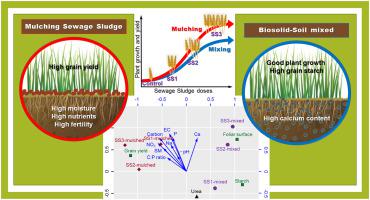Chemosphere ( IF 8.1 ) Pub Date : 2021-06-07 , DOI: 10.1016/j.chemosphere.2021.131122 Sonia Boudjabi 1 , Haroun Chenchouni 1

|
The fertilization using sewage sludge (SS) and/or SS-derived products have been extensively studied and known to increase crop yield as soil nutrients and plant growth are improved. This study aimed to evaluate two SS application methods (i.e. mulching and mixing with the soil) on soil fertility parameters and the productivity of cereal crops. It compared the effect of SS fertilization methods on changes in soil physicochemical parameters in order to highlight the application mode which gives the best agronomic values and sustains soil productivity. Foliar surface, grain starch content and grain yield of durum wheat (Triticum durum) were determined in plants grown in plastic planters for different fertilization treatments (SS-mulched, SS-mixed, urea, and unfertilized). Each SS treatment was applied in three levels (SS1 = 1% w/w ratio, SS2 = 4%, SS3 = 8.3%). The application of SS improved all soil properties compared to the control and urea, with the SS mulching treatment was the best. The significant improvement of soil fertility was confirmed by soil C:P ratio which indicated a good soil mineralization status, in particular under the screen formed by mulching that helped to conserve high soil moisture for optimizing plant growth. Soil calcium accumulated in greater amount in biosolid-soil mixtures than in SS-mulched soils. Regardless of SS doses, the highest crop grain yields were obtained with the SS mulch treatments. Mulching SS, compared to SS-mixed soils, brings better results in terms of improving soil fertility and yielding high productions. The applicable of this method is also easy in the field and/or large-scale cultures.
中文翻译:

关于污水污泥土地应用的可持续性:如何应用污水生物固体以提高土壤肥力和增加作物产量?
使用污水污泥 (SS) 和/或 SS 衍生产品施肥已被广泛研究,并且已知可随着土壤养分和植物生长的改善而提高作物产量。本研究旨在评估两种 SS 施用方法(即覆盖和与土壤混合)对土壤肥力参数和谷类作物生产力的影响。它比较了 SS 施肥方法对土壤理化参数变化的影响,以突出提供最佳农艺价值和维持土壤生产力的施用模式。硬粒小麦(Triticum durum )的叶面、籽粒淀粉含量和籽粒产量) 在塑料花盆中针对不同施肥处理(SS 覆盖、SS 混合、尿素和未施肥)生长的植物中测定。每种 SS 处理以三个水平应用(SS1 = 1% w/w 比率,SS2 = 4%,SS3 = 8.3%)。与对照和尿素相比,SS 的施用改善了所有土壤性质,其中 SS 覆盖处理效果最好。土壤肥力的显着提高由土壤 C:P 比证实,表明土壤矿化状态良好,特别是在覆盖形成的筛网下,有助于保持高土壤水分以优化植物生长。与SS覆盖的土壤相比,生物固体-土壤混合物中土壤钙的积累量更大。不管 SS 剂量如何,使用 SS 覆盖物处理获得最高的作物谷物产量。与 SS 混合土壤相比,覆盖 SS,在提高土壤肥力和高产方面带来更好的效果。这种方法在现场和/或大规模培养中也很容易应用。










































 京公网安备 11010802027423号
京公网安备 11010802027423号